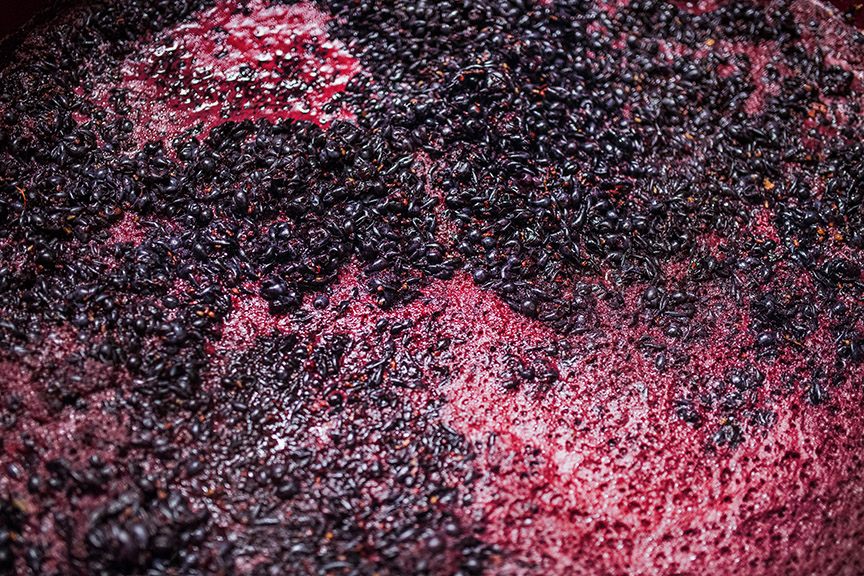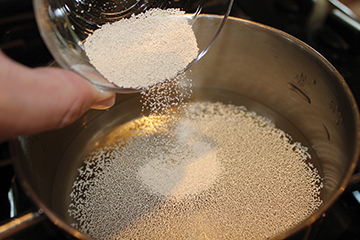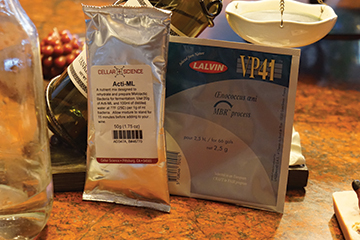Fermentation on the Mind
As someone deeply immersed in the world of winemaking, I have a profound appreciation for fermentation techniques, aids, and yeast. My go-to question for every winemaker I meet is, “What’s your favorite yeast strain?” I proudly embrace my role as a primary fermentation enthusiast and am always eager to expand my knowledge. With each conversation, I discover new methods and products that pique my interest. In this article we’ll discuss some of my favorite primary fermentation processes and products that I recommend exploring this fall.

Yeast Rehydration
Dry yeast rehydration is beneficial to helping make sure that your fermentation is successful with the best aromatic and flavor profile possible. There are several yeast rehydration nutrient products out there. My favorite is relatively new: Go-Ferm Sterol. This product does not require any big temperature adjustments. You just dilute the amount you need in 10 times its weight in clean, chlorine-free water (the water must be above 59 °F/15°C), add your dry yeast, stir gently, let stand for 15 minutes, and then add the yeast slurry to your wine must and away fermentation goes! Gone are the days of getting yeast to the perfect temperature to pitch or just saying “whatever” and sprinkling inactive dry yeast onto your must and hoping for the best. No more fermentation roulette.

There are many other yeast rehydration products out there, though others generally require the rehydrated yeast temperature and must temperature to be within about 15 °F (8 °C) of each other. All of these yeast hydration nutrients will enhance the quality and consistency of your wine. They provide essential nutrients and protective compounds that help revive and strengthen the yeast cells, ensuring they are healthy and active when they are added to the must or juice. Properly rehydrated yeast can lead to a more consistent and complete fermentation process. This can prevent issues like stuck or sluggish fermentations, where the yeast stops converting sugars into alcohol before the process is complete. A lot of times you hear winemakers having stuck fermentations due to temperature in their winemaking cellars. This addition helps counteract that. If you have large temperature swings in your winemaking cellar, rehydration products contain compounds that help yeast cope with these stresses, improving their performance and survival rate.
A healthy and vigorous yeast can contribute to better flavor and aroma profiles in the wine. They can produce desirable fermentation byproducts that enhance the complexity and quality of the wine. By using rehydration products, winemakers can achieve more predictable and reliable fermentation outcomes, reducing variability between batches and improving overall wine quality.
Yeast Nutrients
In keeping with the subject of yeast health, let’s move on to yeast nutrients. Insufficient nutrients can lead to stuck or sluggish fermentations. These nutrients support yeast metabolism and growth, ensuring a healthy fermentation process by supplying essential nutrients such as nitrogen, vitamins, amino acids, and minerals that are crucial for yeast health and activity.
Adequate nutrient supply helps yeast cells to better tolerate the increasing alcohol levels as fermentation progresses. This is particularly important in high-alcohol wines where yeast may otherwise struggle to survive and complete fermentation. Coupled with this, you would need yeast that can handle a high-
Brix fermentation.
These nutrients are a big help to native fermentations as well. When winemakers use wild or indigenous yeast strains, which may not be as robust as commercial yeast, nutrient supplementation can help support a healthy fermentation and reduce the risk of fermentation problems.

Ever have a “stinky” fermentation? One that smelled like rotten eggs? The likely culprit is that the yeast cells are not getting enough food during fermentation. This is an early sign of a possible stuck fermentation and/or a wine ending up with off-flavors. Nutrient-deficient yeast can produce undesirable byproducts like sulfur compounds and other off-flavors. By providing the necessary nutrients, you can reduce the risk of these off-flavors, resulting in a cleaner and more desirable flavor profile.
My favorite products for these additions are Fermaid-O and Fermaid-K. Fermaid-O is a workhorse made up of organic nitrogen (amino acids), vitamins, and minerals. It is best to add this early on in fermentation. Either the same day or the day after your initial yeast pitch. Fermaid-K is usually added at around 12–8 °Brix. It is the last push towards the alcoholic fermentation finish line. Fermaid-K is made up of a blend of organic nitrogen (amino acids) and inorganic nitrogen (diammonium phosphate), with added vitamins and minerals. Both are an easy dilution of your chosen dose in 10 times its weight in chlorine-free water. Pour into the must, mix, and you’re done.
There are also nutrient products such as Opti-Red and Opti-White. These help with preserving color, softening mouthfeel, and can act as an antioxidant, helping protect aromas. Each is another quick addition that can help level up your wines if you’ve had issues preserving color and mouthfeel during fermentation in the past.
Yeast nutrient products can be a key component in your winemaking to help ensure a healthy, efficient, and predictable fermentation process, ultimately leading to high-quality wine.
Protective and Sacrificial Tannins
Utilizing tannins during wine fermentation is a great resource. They are easy to add during fermentation and they bring a ton of advantages, not just for the sensory profile either! Tannins added at fermentation help enhance the wine’s structure, stability, and overall sensory profile. A simple dilute, dump, and mix addition brings forth a ton of benefits:
• Tannins contribute to the body and mouthfeel of wine, providing astringency and texture that can balance the sweetness and acidity. This helps in creating a well-rounded and complex wine.
• They interact with anthocyanins (color compounds in grape skins) to form stable pigment complexes. This helps stabilize and enhance the color of the wine, particularly important in red wines.
• Sacrificial tannins, often added early in the winemaking process, bind with oxygen and protect the delicate grape tannins from oxidation. By doing this, they help preserve color, structure, and flavor during fermentation and aging. Without sacrificial tannins, your wine could end up looking tired and tasting flat. But with these unsung heroes, the wine stays vibrant and full of life, ready to impress when it’s time to pop the cork.
• Tannins have antioxidant properties that help protect the wine from oxidation during fermentation and aging. This can preserve the freshness and vibrancy of the wine’s flavor and aroma.
• They can have antimicrobial effects, inhibiting the growth of unwanted bacteria and spoilage organisms during fermentation. This can contribute to a cleaner and more controlled fermentation process.
• Tannins enhance aging potential. Wines with appropriate tannin levels tend to age better, developing more complex flavors and aromas over time. Tannins contribute to the wine’s longevity and ability to improve with aging.
• Adding tannins can help achieve a better balance between the various components of the wine, such as fruit, acidity, and alcohol. This balance can lead to a more harmonious and complex wine.
• Tannins can help bind and precipitate certain compounds that contribute to off-flavors, improving the overall sensory quality of the wine.
• Finally, tannins can be used as a fining agent to help clarify the wine by binding to proteins and other particles, making them easier to remove.
My favorite fermentation tannins are FT Rouge (intended for red wines), FT Blanc (for white/rosé wines), and the newest member of the tannin crew for my fermentation plans — FT Rouge Berry (for red/rosé wines). FT Rouge is a powerhouse for promoting color stability. It helps offset astringent characteristics and is a great antioxidant if you have any fruit that came into contact with mold, whether on the vine, during your cold soak, and or during fermentation. FT Blanc can help protect color, remove some heat proteins, is a great antioxidant, and contributes some minerality to the flavor profile. FT Berry Rouge is similar to FT Rouge but is also useful in bringing out berry character and masking any green characteristics.
Overall, the strategic use of tannins during wine fermentation can enhance the wine’s quality, stability, and aging potential, contributing to a more refined and enjoyable wine by the time it fills your glass.
Non-Saccharomyces Yeasts
This subject that is gaining a lot of attention lately. Traditionally, Saccharomyces cerevisiae has been the primary yeast used in winemaking due to its reliability and efficiency in fermenting sugars to alcohol. However, non-Saccharomyces yeasts are gaining attention for their ability to produce unique flavors, sensory characteristics, and enhance wine complexity akin to natural fermentations.
Non-Saccharomyces yeasts such as Hanseniaspora, Torulaspora delbrueckii, and Metschnikowia are naturally present on grape skins and in the winery environment, but are typically outcompeted by Saccharomyces cerevisiae during fermentation. By inoculating grape must with selected non-Saccharomyces yeast strains or allowing indigenous populations to participate in fermentation, winemakers can introduce a diverse array of aroma compounds such as fruity esters, floral notes, and spicy phenols. Co-fermentation with non-Saccharomyces yeasts offers winemakers a tool for crafting wines with distinctive aromatic profiles and enhanced complexity, reflecting the microbial diversity of their vineyards. For more on these yeasts, read “Call of the Wild” from the August-September 2023 issue at: www.winemakermag.com/article/call-of-the-wild
Fining at Primary Fermentation
Fining during primary fermentation is a technique I hadn’t considered before recently. However, after hearing about it and researching it further, I’ve discovered some significant time-saving benefits. As someone who always aims to assist my “future self,” I believe this method fits perfectly into that category for winemaking. Benefits of fining at primary fermentation include:
• Fining agents help to remove suspended particles, proteins, and other impurities that can cause haze or cloudiness in the wine. This results in a clearer, more visually
appealing wine.
• By removing proteins and other unstable compounds, fining can help to prevent unwanted chemical reactions that might occur during storage, such as protein hazes or oxidative spoilage.
• Fining can help to reduce or eliminate off-flavors and off-aromas that can arise from certain impurities or microbial activity. This leads to a cleaner and more desirable flavor profile.
• Some fining agents can help to smooth out the texture of the wine, reducing astringency and bitterness by removing excess tannins and other phenolic compounds.
• Certain fining agents can help to reduce microbial loads by removing bacteria and yeast cells, thus reducing the risk of spoilage and fermentation problems.
• Fining can accelerate the natural settling process, allowing the wine to clear more quickly and efficiently. This can be particularly beneficial in commercial production where time is a critical factor.
Different fining agents target specific compounds, allowing winemakers to selectively remove undesirable components without stripping away desirable characteristics. This level of control can help to achieve a more balanced and refined final product. A great product is Vegefine. It is a 100% vegetable protein-based clarification agent. It helps ensure effective fining, it is very easy to use, and can be used for organic wines as well as non-organic wines. When used during primary fermentation it helps eliminate oxidizable phenolic compounds, which results in a smaller amount of sediment. It also helps stabilize the color and eliminate harsh tannins and astringencies for red wines. Using it requires a dilution of 10 times its weight in chlorine-free water, stirring, and then adding to the must before doing a pumpover or punchdown to ensure it homogenizes with the must. You can add this pre-fermentation, during fermentation, or post-fermentation.
Overall, fining during primary fermentation is a valuable tool in the winemaker’s arsenal to ensure the production of high-quality, stable, and aesthetically pleasing wine.
Cryo-Extraction and Cryo-Fermentation
These are techniques that might be interesting to try depending on how adventurous you are. If you are using frozen must, you are already part of the way there! Cryo-extraction and cryo-fermentation are innovative techniques that involve freezing grape must or juice prior to fermentation. Cryo-extraction, also known as cryo-maceration, involves freezing whole grapes or grape clusters before pressing to extract concentrated juice with enhanced aromatics and color intensity. Cryo-fermentation, on the other hand, involves freezing grape must or juice after pressing but before fermentation begins. Freezing the must or juice concentrates sugars and flavor compounds while minimizing the extraction of harsh phenolic compounds, resulting in wines with heightened fruitiness and smooth tannins. Additionally, cryo-fermentation can help control fermentation temperature and slow down yeast metabolism, leading to more gradual and controlled fermentation kinetics.
While cryo-extraction and cryo-fermentation require specialized equipment and careful process management, they offer winemakers a powerful tool for enhancing wine quality and complexity. If you are doing a small batch and have the ability to try this in a chest freezer, it might make for an interesting experiment.
Co-Fermentation
This is one of my top recommendations. We often receive calls in the spring and summer from people experiencing corks popping in their cellars. The primary reason for this issue is usually incomplete malolactic fermentation after its introduction post-fermentation, which then reactivates and finishes fermenting after bottling. Conducting a primary co-fermentation with malolactic fermentation (MLF) provides several advantages that can improve both the winemaking process and the quality of the final product:
• Co-fermenting can significantly reduce the overall fermentation time. This allows winemakers to move to subsequent steps, such as aging and bottling, more quickly.
• It can lead to better integration of flavors. The simultaneous conversion of malic acid to lactic acid and sugars to alcohol can create a more harmonious and balanced flavor profile, contributing to a smoother and more complex wine.
• If buttery flavors are not your goal, it is even more beneficial. Yeast will actively consume diacetyl, so co-fermenting yeast and MLF bacteria allows the softening effect from MLF while minimizing the buttery flavors and aromas that come from MLF done after primary.
• It can help establish a stable microbial environment. The presence of active yeast and lactic acid bacteria can suppress the growth of spoilage organisms, reducing the risk of off-flavors and other wine faults.
• The controlled environment of co-fermentation can result in more consistent quality from batch-to-batch. This predictability is crucial for commercial wineries aiming to maintain a uniform product.
• Primary fermentation generates heat, which can be beneficial for MLF bacteria that prefer warmer temperatures. Co-fermentation can create optimal conditions for both yeast and bacteria, promoting efficient fermentation processes. Please note that the fermentation temperature is around 70 °F (21 °C) as a best practice for pitching MLF during primary fermentation.
• MLF requires some oxygen, which is naturally present during primary fermentation. This can reduce the need for additional oxygenation steps, simplifying the process and reducing the risk of oxidation.
• By initiating MLF early, winemakers can prevent potential issues with stuck fermentations that might occur if MLF is delayed. This ensures a more reliable and complete fermentation process.
In short, co-fermentation enhances the efficiency, quality, and consistency of winemaking.
Whether you’re a home winemaker or run a professional winery, these tools are easy to use and can help facilitate a successful fermentation, taking your wines to the next level.
Remember, if you ask ten winemakers how to make wine, you’ll get 20 different answers. If you love your wine as it is, there’s no need to change it. But if you’re eager to try something new, I hope something in this list catches your eye and gives you the confidence to experiment this fall.





